Excerpts from Swan Lake - Pyotr Ilyich Tchaikovsky

Excerpts from Romeo & Juliet - Sergei Prokofev
Overture to A Midsummer Nights Dream - Felix Mendelssohn
in collaboraton with Borderlands Ballet Company
Las Cruces Chamber Ballet
NMSU Department of Theatre Arts


2


3
Letter from the President
Dear Patrons, Welcome to our 2023-24 season of the fnest symphonic music, performed by our dedicated orchestra under the directon of Maestro Ming Luke. This will be a season of change as we try new things and collaborate with other arts organizatons in excitng ways. Whether it be joining our music with the arts of ballet and drama, the joining of cultures in celebraton of Día de los Muertos, the joining our instruments with choral voices for the holidays, or just humming along with our favorite tunes from the movies, we recognize that music has the ability to touch everyone. As the saying goes, “Where words fail, music speaks”.
We also recognize our responsibility to educate and develop the next generaton of musicians through the development of our The Las Cruces Symphony Youth Orchestra and our newly formed Junior Orchestra! We are excited that the Youth Orchestra will again be joining us onstage, not once, but twice this season.
Our mission is to present and promote music of the highest quality for the region’s enrichment and to serve our community. This would not be possible without the fnancial support of you who are here, our season sponsors, business advertsers, and donors. We are truly thankful for your generosity and look forward to your contnued support.

Sincerely,
Michael Chang LCSA President
4
Las Cruces Symphony Association
The mission of the Las Cruces Symphony Associaton is to present and promote music of the highest quality for the region’s enrichment, and to serve our community as a musical, cultural, and educatonal resource
2023-24 Board of Directors
Michael Chang
Larry Hill
Georgina Lavery
Scot Lucas
Marc A. Mofet
Barbara Ross
Carmen Rustenbeck
Laura Self
Catherine Zaharko
Executve Board
Michael Chang, President
Marc A. Mofet, Vice-President
Larry Hill, Secretary
Carmen Rustenbeck, Treasurer
Ex-Ofcio
Carmen Rustenbeck, Interim Executve Director
Ming Luke, Music Director
The Las Cruces Symphony Associaton is the administratve and governing arm of the Las Cruces Symphony Orchestra, governed by a Board of Directors composed of local community members.
A successful symphony orchestra is a partnership between the music director, musicians, administratve staf, board of directors, donors, and patrons. Actng on behalf of all who have a vested interest in the LCSO, the Board of Directors is responsible for the good stewardship of the Symphony.
For more informaton about the LCSA Board o f Directors and membership possibilites, please contact the LCSA at 575 -646-3374.
5
Classics One: Love’s Soul
Sponsored by Charles and Nita Schwartz ~ Friends of Mathematcs & Music
The Las Cruces Symphony Orchestra
Ming Luke, Music Director & Conductor
In collaboraton with
Borderlands Ballet Company − Monique Foster, Artstc Director
Las Cruces Chamber Ballet Kevin Self, Artstc Director
NMSU Department of Theatre Arts Wil Kilroy, Chair
present
Overture to Midsummer Night’s Dream - Felix Mendelssohn
Excerpts from Swan Lake Pyotr Ilyich Tchaikovsky
Las Cruces Chamber Ballet
Pas de Six Variaton V (Black Swan Solo)
Melody Hernandez (White Swan) & Alexandra GoodTracks (Black Swan)
Danse Espagnole (Spanish)
Chloe Duton & Malakai Garcia (Saturday)
Samantha Brasher & Malakai Garcia (Sunday)
Danse Napolitaine (Neapolitan)
Kynley Cartwright & Miya Hernandez
Borderlands Ballet Company
Cygnets
Brooke Gonzales, Janelle Hernandez, Olivia Leon, Naomi Zmuda
White Swan PDD Adagio
Juliana Garcia & Joshua Godman
Corps: Tara Gandy, Brooke Gonzales, Janelle Hernandez, Olivia Leon, Cienna Parker, Naomi Zmuda
Black Swan - entree, adage
Rachel Breck & Daniel Lindsay
Black Swan - Coda
Rachel Breck & John Pohl
6
Classics One: Love’s Soul
~ Intermission ~
Excerpts from Romeo and Juliet Sergei Prokofev
NMSU Department of Theatre Arts
Cast: Reagan Szulc (Juliet), Delaney Dwyer (Romeo), Tanya Camargo (Prologue/Epilogue), Guillermo Portllo (Capulet and Epilogue)
Montagues And Capulets - Suite 2, No. 1
Young Juliet - Suite 2, No. 2
Minuet (the Arrival of the Guests) - Suite 1, No. 4

Masks - Suite 1, No. 5
Romeo and Juliet (Balcony Scene and Love Dance) - Suite 1, No. 6
Death of Tybalt - Suite 1, No. 7
Romeo at the Tomb of Juliet - Suite 2, No. 7
7
Program Notes: Tchaikovsky
Peter Ilyich Tchaikovsky (1840-1893)

Tchaikovsky is by far the most famous of all Russian romantic composers. The nationalistic spirit was particularly strong among a group of five Russian composers Balakirev, Borodin, Cui, Mussorgsky, and Rimsky-Korsakov and while Tchaikovsky shared their ideals in general, his music was considered more “cosmopolitan,” drawing inspiration from Italian, German, and French music as well as his native Russia. Tchaikovsky was born in a small Russian village, destined, it seemed, for the life of a civil servant. That all changed when he made the decision to study composition with Anton Rubinstein at the new St. Petersburg Conservatory. Rubinstein later recommended Tchaikovsky for a teaching position at a new conservatory in Moscow, which the young composer gratefully accepted. Tchaikovsky suffered great bouts of depression, frequently attributed to his selfdisappointment about his secret homosexual tendencies. In an effort to “cure” himself, or perhaps simply to provide a respectable facade for his lifestyle, Tchaikovsky married a female student who was madly in love with the composer. The marriage was a complete disaster and pushed Tchaikovsky to the edge of a nervous breakdown.
Salvation came in the form of a wealthy patron of the arts named Madame Nadezhda von Meck. She provided the composer an annual stipend, as well as regular commissions of new works. Her only stipulation was that she and Tchaikovsky never meet. They did, however, carry on an extensive, intimate correspondence, and many of their letters still exist. It was a great personal blow to the composer’s emotional state when he lost von Meck ’s support in 1890, though by that time he was quite secure financially. There is some controversy surrounding Tchaikovsky’s death. The composer had gone to St. Petersburg to conduct his Sixth Symphony, which he had subtitled Pathétique. The work did not meet with great acceptance. At this time in St. Petersburg there was a deadly outbreak of cholera, and Tchaikovsky was warned against drinking untreated water. Some suggest that he drank a glass of infected water as a sort of suicide attempt, whereas others say it was pure carelessness. Still other historians suggest Tchaikovsky simply committed suicide by taking poison in an attempt to avoid being exposed in a homosexual scandal that would have involved the composer and a wealthy aristocrat.
8
© Shutterstock.com
Program Notes: Tchaikovsky
Tchaikovsky’s extensive compositional output includes major works in almost every important musical genre. His operas, symphonies, concert overtures, concertos, ballets, string quartets, and various vocal music are some of the most frequently performed works in the entire world of classical music. His works are powerful, emotion-filled crowd pleasers. Among his most famous compositions are the Fourth, Fifth, and Sixth Symphonies; the concert overtures Romeo and Juliet and the 1812 Overture (yes, it really does have a part for a cannon); the operas Eugene Onegin and The Queen of Spades; the ballets Swan Lake and The Nutcracker; concertos for piano and violin, as well as the Variations on a Rococo Theme for cello and orchestra; and the choral work Liturgy of St. John Chrysostom. Tchaikovsky’s formal structures aren’t always perfect, his orchestration is sometimes cumbersome and thick, but for sheer listening pleasure and musical drama, he will always remain an audience favorite.
It is quite hard to believe today, but according to history, the initial performances of Tchaikovsky’s Swan Lake were not well received. Today, of course, this is some of the most famous music ever written for use at the ballet. The scenario is most likely drawn from both Russian and German folks tales, although there is still some controversy is history circles as to the composer ’s actual sources. The basic story is about a princess named Odette who is turned into a white swan by a curse placed on her by Baron Von Rathbart, an evil wizard. Princess Odette has a love interest, of course, named Price Siegfried. There’s also a black swan, Odile, who is actually Rathbart’s daughter. Sadly, this one does not end well for most everyone involved, but the concluding music is achingly beautiful. Today’s performance will include a variety of scenes drawn from throughout the ballet including the famous Spanish and Neapolitan dances, and music composed for both the white and black swans. You will recognize the tunes, especially if you were ever a Bugs Bunny cartoon fan.
Program Notes by Jim Shearer. Portions of these notes are drawn from MUSIC 101: An Active Listening Guide for a Generation Online by James E. Shearer. Kendall Hunt Publishing Co. Used by permission.
9
Program Notes: Mendelssohn
Felix Mendelssohn (1809-1847)
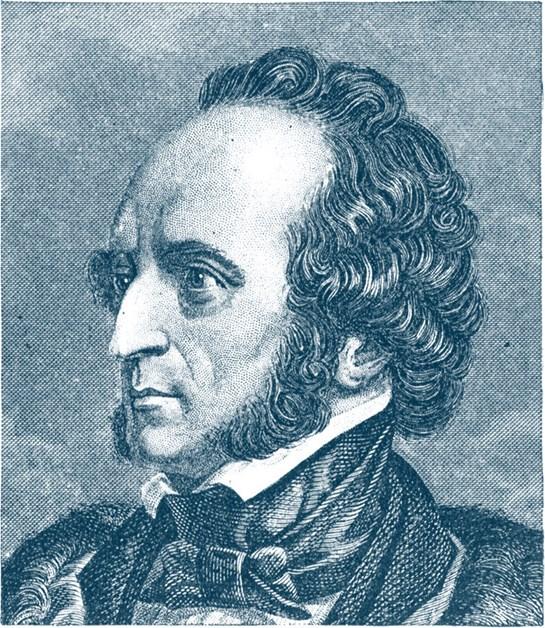
Perhaps even more than Franz Schubert, Felix Mendelssohn can be viewed as a transitional composer whose works help bridge the Classical and Romantic periods in music. He adheres closely to the styles of Haydn and Mozart in terms of formal structures, but the heightened emotional content of his works, his interest in nature, and his use of general programmatic ideas in his instrumental works all point to the Romantic era. Felix Mendelssohn was born into a wealthy Jewish family. His grandfather was the famous philosopher Moses Mendelssohn, and his father, Abraham, was a successful banker. Abraham Mendelssohn made the decision to have his family convert to Christianity in the hopes that they could avoid some of the prejudice many Europeans felt toward the Jewish community. After conversion, the family added the last name Bartholdy, and today you will sometimes see concert programs and recordings that list the composer as Felix Mendelssohn -Bartholdy.
Mendelssohn began to excel in the arts when he was quite young. He played the piano and the violin, composed music, wrote poetry, and even took up painting. While still a teenager, he created a number of successful works that are still performed today, including the Octet, Op.20, and the overture A Midsummer Night’s Dream, Op. 21, based on Shakespeare’s play. Mendelssohn traveled extensively, particularly exploring England, Scotland, and Italy. These travels led to the composition of several popular programmatic works including his Symphony No. 3 (Scottish), Symphony No. 4 ( Italian), and the Hebrides Overture, which is also known as Fingal’s Cave. At the age of 26, Mendelssohn was appointed conductor of the Leipzig Gewandhaus Orchestra. Under his direction the orchestra became a very successful performing organization, a position it maintains in the world of music to this day. While in Leipzig, Mendelssohn also became the director of a new music conservatory there. Throughout all of his travels and conducting activities, Mendelssohn continued to be a very prolific composer. In terms of compositional temperament, he has been compared to Mozart. Music flowed easily from his pen, and he seemed to always have a perfect sense of orchestration and formal structure.
10
Source: Jupiterimages, Corp.
Program Notes: Mendelssohn
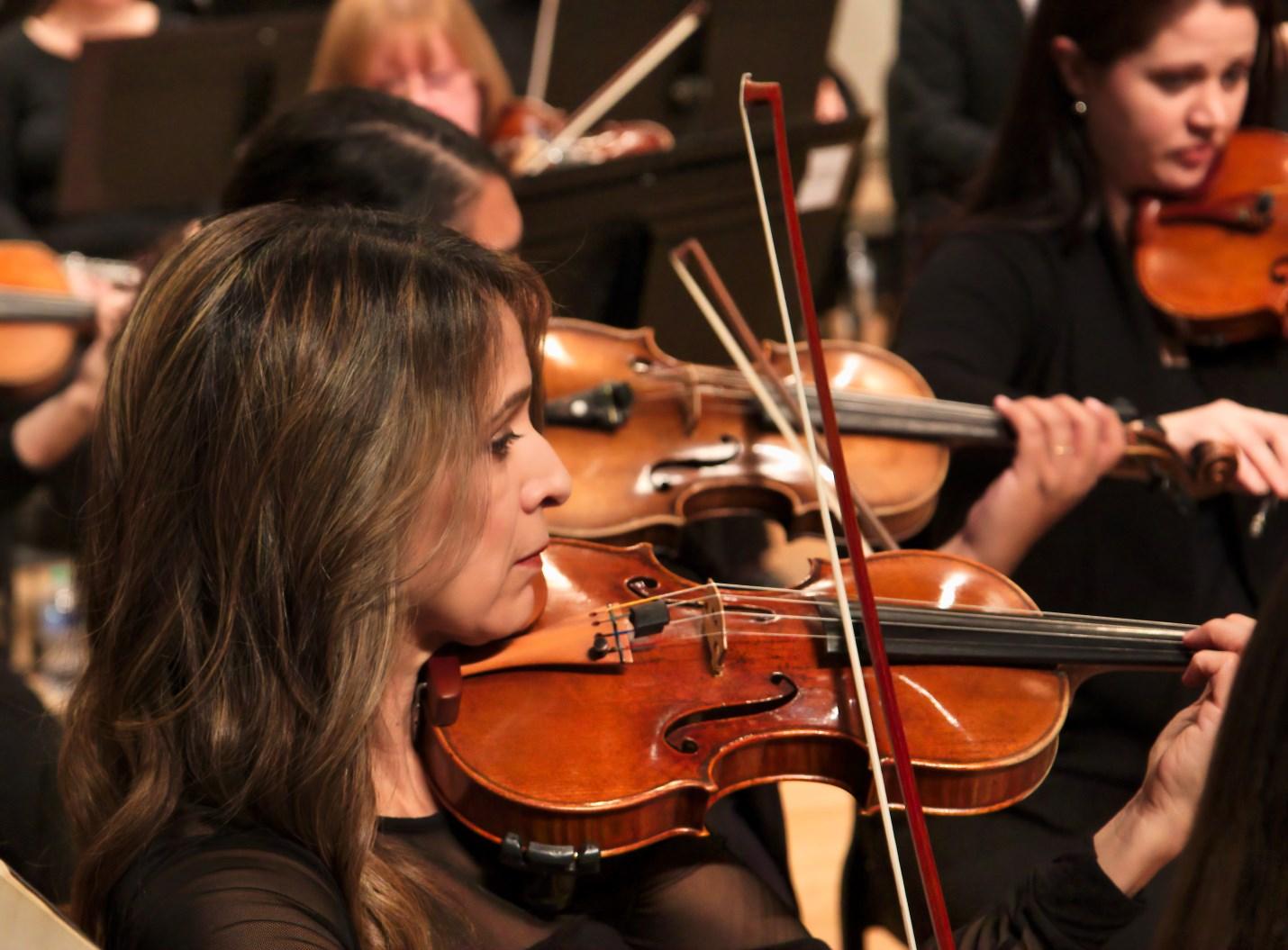
Over the past 20 years or so, music historians have become fascinated with Felix Mendelssohn’s older sister, Fanny. In many ways, she seems to represent an entire era of female composers and performers who have been completely overlooked, their works unpublished and now lost to history. Like her famous younger brother, Fanny Mendelssohn demonstrated a tremendous early talent for music. The siblings remained close throughout their entire lives. She died at the age of 41 after suffering a stroke, and, distraught over his sister ’s death and suffering from exhaustion, Felix Mendelssohn passed away a few months later.
As mentioned above, Mendelssohn wrote the overture for A Midsummer Night’s Dream when he was only 17 years old. It was originally created as a “concert overture” for use in the symphony hall, though it is sometimes now used during productions of the actual play by William Shakespeare. Toward the end of his life, Mendelssohn also wrote some incidental music to be used in play productions (which includes his famous “Wedding March” so universally loved around the world), but today, the Las Cruces Symphony will focus only on the famous overture. The work opens with four of the most famous chords in all of classical music, and they will lead you into Shakespeare ’s world of elves, faeries, lovers, magic and one very noisy donkey. (Well, it's actually a man whose head got turned into a donkey by the mischievous faerie, Puck. It ’s kind of complicated if you don’t already know the story.)
11
Sergei Prokofiev (1891-1953)

Like his contemporaries Rachmaninoff and Bartók, Prokofiev established himself as a successful concert pianist as well as an important composer. Over his numerous compositions, Prokofiev experimented with Neo -Classicism, Nationalism, and various twentieth -century compositional techniques including both harmonic and rhythmic complexities. His music is frequently referred to as being “witty,” some would even say “sarcastic.” Even today, his prodigious compositional output continues to gain acceptance among the concert-going and recordbuying public. Over his career, Prokofiev wrote eight operas, seven ballets, seven symphonies, five piano concertos, two violin concertos, seven major choral works, ten piano sonatas, and a wealth of other music for ensembles both large and small. By title, some of his most historically important works include Romeo and Juliet (both a ballet and an orchestral suite), Symphony No. 1 (Classical), Symphony No. s tale for narrator and orchestra), Alexander Nevsky (both a film score
Unlike another fellow Russian composer, Dimitri Shostakovich, Prokofiev spent many years living abroad, outside the dominating Soviet artistic world. As such, he had much more freedom as a composer to explore and experiment during major portions of his career. Despite the artistic oppression he knew he would face, however, he returned home for good in 1936. Back under strict Soviet rule, he had to rein in his more experimental, dissonant, and what the Soviet Government called “formalistic” tendencies. It was this need for more conformity that led to works like the ballet score for Romeo and Juliet. He started the work much earlier, but it was heavily revised before its premiere in Russia. As mentioned above, beyond being a standard ballet score, Prokofiev also extracted two full suites of music for use by symphony orchestras in the concert hall, a practice that became a standard tradition in the nineteenth century and remains so even today with suites drawn from modern operas, ballets, film scores, and video games. Today’s performance by the Las Cruces Symphony will include portions drawn from both suites and will include some of the most recognizable music from this masterpiece of modern composition.
12
Photo: Pierre Choumoff
Violin I
Classics One − Personnel
Conductor: Ming Luke
Sponsored by Jean Pritchard Viola
Brigid McCarthy* Concertmaster
~Jean Pritchard
~Arturo & Maria Elena Jurado
Cristna Leony
~Jean Pritchard
Vanessa Cedillos
Jasmine Gomez
Santago Rodriguez III
Daniel Rivera Jr.
Angel Ornelas
Kevin Wilson^
Javier Garcia-Rivera^
Albert Yoshimoto
Violin II
Elizabeth Zamora*
~Candis Stern
Shelly Wood
Jennifer Rogers
Teresa Kristovich
Miranda Ludeman
Paola Gabbi-Madrid
Diana Gilliland
Osvaldo Altamirano
Melissa Warr
Jesse Galindo
Jorge Martnez-Rios*
~Jean Pritchard
Monica Arredondo
~Arturo & Maria Elena Jurado
Kathleen Hill
Douglas Pof
Barbara Creider
Elisabeth Greene
Julio Campos
Cello
Hyerim Mapp**
~James Gerwels & Tifni Reimann
Cesar Camarena
Alina Vasquez
Leslee Becker
Emma Alvarez^
Kateri Buntng^
Isaac Reynaga^
Guillaume Agnew^
Bass
William Scholten*
Ian Narlock
Robert Taylor
Robert Palacios
13
a Chair Sponsors Principal * Actng Principal ** Student ^
~Adopt
Classics One - Personnel Cont’d
Flute
Joy Zalkind*
Jesus Candela
Jennifer Gonzalez
Oboe
Charlote Ethington**
Kevin Let – Oboe/English Horn
Francisco Javier Renteria
Clarinet
Madelyn Moore**
~Jefrey Brown
John De La Paz
Raul Olivas^ – Bass Clarinet
Bassoon
Cara Lufey*
Kathleen Lestone
Rusty Smith – Contrabassoon
Saxophone
Rhonda Taylor*
Horn
Nancy Joy*
Kim Beasley – asst.
~Don & Pat Johnson
Mary Mendez
Kristen Silver
John Groves
Trumpet
Steve Schiller**
Paul McLaughlin
Jacob Dalager
Trombone
Allan Kaplan*
Frank Otero
John Feeny
Tuba
Clint Sims**
Timpani
Fred Bugbee*
~Michael Chang
Percussion
Newell Ramsey*
Anthony Guerrero^
Gabriel Garcia-Rivera^
William Reeves^
Harp
Vanessa (Hsin Hsin) Gong*
Piano
Esequiel Meza*
Stage Manager
Lessie Smithhisler
Librarian
Jesse Galindo
Personnel Manager
Larry Hill
~Adopt a Chair Sponsors
14
Principal * Actng
Principal ** Student ^
Pops One: Día de los Muertos
The Las Cruces Symphony Orchestra
Ming Luke, Music Director & Conductor
in collaboraton with
Paso del Norte Chamber Orchestra from Juarez Jorge Martnez-Rios, Music Director
Michele’s Dance Academy: Ballet Folklorico Pasos del Alma Marissa Cordero, Director
Dancers: Adrianna Cordero, Liliana Delgado, Alina Flores, Alexandra GoodTracks, Melody Hernandez, Renesmae Martnez

Las Cruces Symphony Youth Orchestra Jorge Martnez-Rios, Music Director present
Dances from Three Cornered Hat Manuel de Falla
Danzon No. 2 Auturo Marquez
(with the Las Cruces Symphony Youth Orchestra)
La Llorona arr. by Valentno Salado Erick Giovanni
La Culebra arr. by Manuel Esperon
Conga del Fuego Nuevo by Arturo Marquez
The Children of Sanchez by Chuck Mangione/Arr. Bob Phillips and Jerry Dennison
Huapango Del Oso by Gabriel Musella
15
Classics Two: Handel’s Messiah

Sponsored by M.U.S.I.C. and Glennis Adam
The Las Cruces Symphony Orchestra
Ming Luke, Music Director & Conductor
Sinfony
Scene 1
There were shepherds abiding in the
And lo, the angel of the Lord came
Scene 2
Michael Dix, Bass
But who may abide the day of His coming
For he is like a refner's fre
Sarah Daughtrey, Mezzo Soprano
And He shall purify the sons of Levi
Scene 3
Behold, a virgin shall conceive
O thou that tellest good tdings to Zion
Sarah Daughtrey, Mezzo Soprano
For behold, darkness shall cover the earth
The people that walked in darkness
Michael Dix, Bass
For unto us a Child is born
Hallelujah
And suddenly there was with the
Sarah Neely, Soprano
Glory to God in the highest Scene 5
Rejoice greatly, O daughter of Zion
Sarah Neely, Soprano
Then shall the eyes of the blind be open'd
Sarah Daughtrey, Mezzo Soprano
He shall feed His fock like a shepherd
Come unto Him, all ye that labour
Sarah Neely, Soprano
Sarah Daughtrey, Mezzo Soprano
His yoke is easy, His burthen is light
Hallelujah
16
Masterworks Chorus & NMSU Choirs Stephanie Reyes, Music Director
Pops Two: The Silver Screen
The Las Cruces Symphony Orchestra
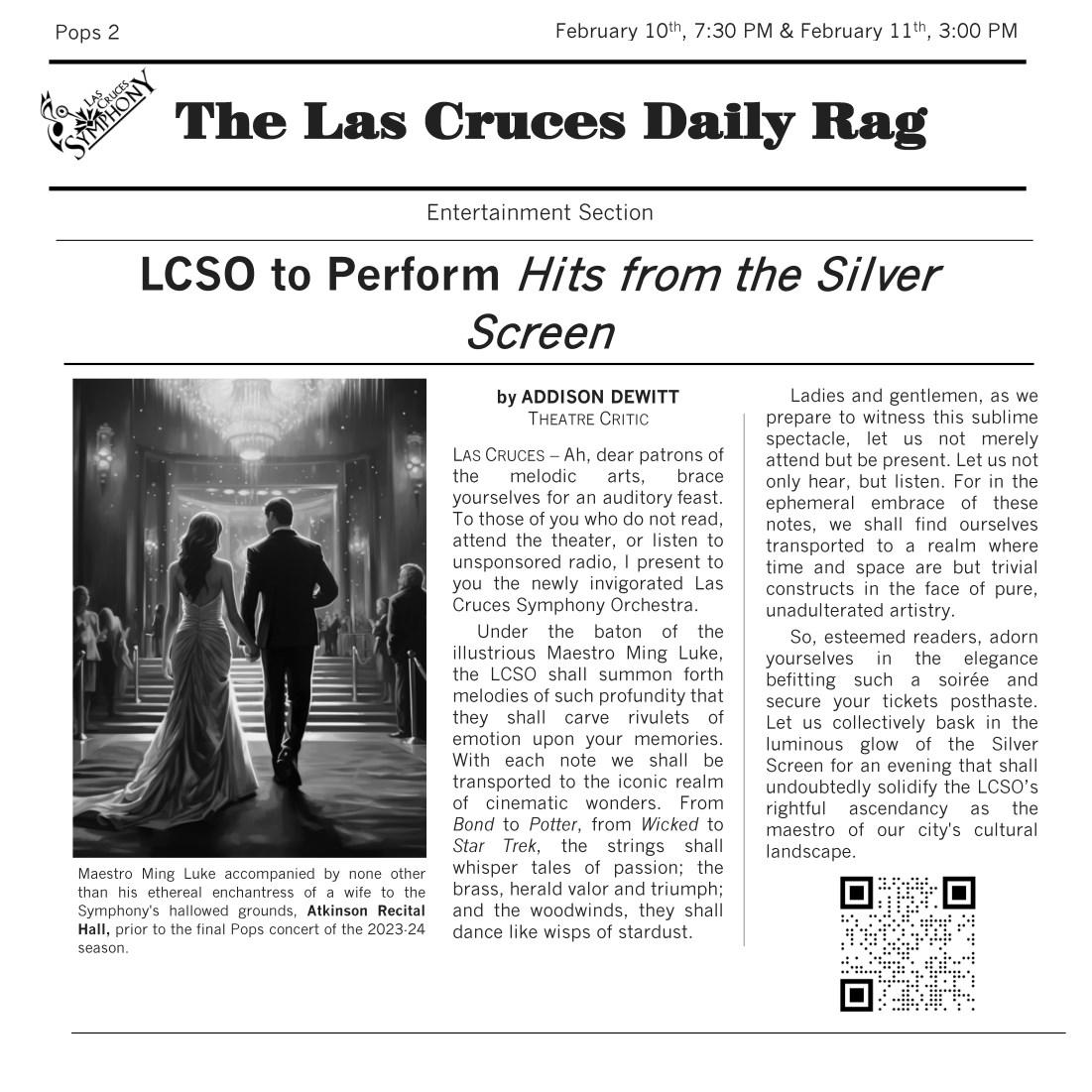
Ming Luke, Music Director & Conductor
presents
007: Through the Years Various Arr. Bulla
Highlights from Wicked Stephen Schwartz Arr. Rickets
Music from Frozen Kristen Anderson-Lopez Arr. Krogstad
Star Wars Through the Years John Williams Arr. Bulla
Highlights from Jurassic Park John Williams Arr. Custer
Star Trek Through the Years Various Arr. Custer
Harry Poter Symphonic Suite John Williams Arr. Brubaker
17
Classics Three: Earth & Space

Sponsored by A Circle of Symphony Friends
The Las Cruces Symphony Orchestra
Ming Luke, Music Director & Conductor
in collaboraton with Las Cruces Symphony Youth Orchestra, Jorge Martnez-Rios (Music Director)
present
Bedrich Smetana
Die Moldau
(with the Las Cruces Symphony Youth Orchestra)
Heather Pinkham
Nowhere and Nowhen Piano Concerto
Soloist, Heather Pinkham
Claude Debussy
La Mer
18
Art Builds Community
Every great city needs a great symphony!
There is something special about live music. Something special about the moment your concert master initates the fnal tuning of the orchestra; about the moment your conductor takes the podium; about the moment Ming ’s baton drops and the frst chords from your Symphony transport you into a fabulous musical journey.
The Las Cruces Symphony Orchestra is a source of joy and discovery for the people who are engaged in this community. It is an irreplaceable chance for music lovers of all ages and backgrounds to be a part of something unique; an experience that cannot be duplicated by streaming performances online or fying to distant places to watch some other city ’s symphony. As great as those things can be, they are fundamentally diferent.

Listening today, you will not just experience beautful works of music. You will not just experience them in the company of other like -minded people. But you will experience them in the company of hundreds of your neighbors and fellow Las Crucians. In this way, these performances weave together our community.
Thank you for joining us!
19
LCSO Youth & Junior Orchestras
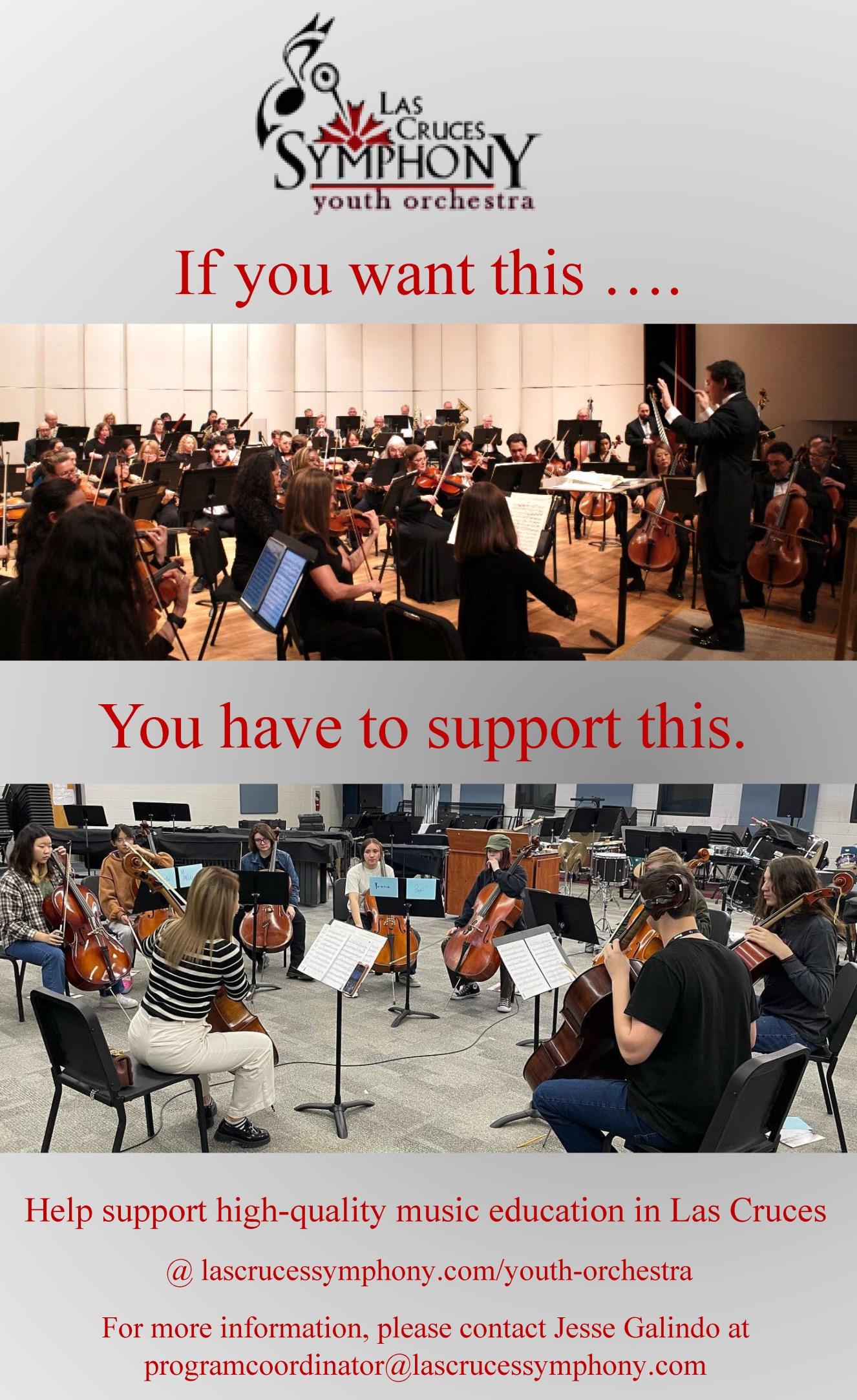
20
Grandioso: $5,000-$9,999
Appassionato: $2,000-$4,999
Glennis L. Adam
Maestoso: $1,000-$1,999
David Brown & Mary Beagle
Elmer & Nancy Houghten
James Gerwels & Tifany Reimann
Richard & Joy Pearce
Julie Marineau
Philip &Louise Silano
Doug & Tina Bailey
Scherzo: $500-$999
Arturo & Maria Elena Jurado
Caryl Kotulak
Janet Hampton
Irv & Barb Ross
Richard & Susan Emery
Darrel W. Dodson
Linda A. Shubeck
Helen Zagona
Francie Casillas
Sue Lashley
Rondo: $250 -$499
Frank Belyan & Paul Mach
Ben Holberg
Shirley Cruse
Charles & Linda Tharp
Jim Maxon
Dolce: $50 -$249
Lee Beaty
Karen Casci
Jefrey Brown
Larry & Connie Candelaria
Thomas & Joan Dormody
Lois Grant & Richard Prat
Sally Ann Harper
Kennan Newtson
Ann Sallemi
Wayne Flowers
Garn Harris
David Card
Ellie Chalekian
Youth Orchestra Founders Circle:
Caryl Kotulak
Jennifer Taylor
Richard & Joy Pearce
Ann Carlson
Larry & Connie Candelaria
Youth Orchestra Sponsors
Marlene Mayfeld
Gordon Butler & Martha Ludeman
Jim Maxon
Lydia Evans
Thomas & Joan Dormody
Edward Aylesworth
James Gerwels & Tifni Reimann
Karen Billings
Henry & Mart Taylor
Ilse Pokorny
Susan Williams
Kennan Newtson
Juliana Boxer
Richard Hiss
Shirley Cruse
Glennis L. Adam
Frank & Cally Williams
Peter & Dael Goodman
Leora Zeitlin
Mary Ann Willson
Lois Grant
Grant & Tenya Price
Ellen Michnovicz
Jefrey Brown
Lucia Greene
Ann Goldsberry
Philip & Louise Silano
Lee Beaty
Emroy Shannon
Kathryn Treat
Gay Lenzo
Barbara C. Davis
Arturo & Maria Elena Jurado
Don & Pat Johnson
Ellie Chalekian
Doug & Tina Bailey
Roger C. Young
Shevek Barnhart
21
LCSO Donors
Become a Donor
Annual Fund
For more than 62 years, the LCSO has been a leader among the arts in Las Cruces, employing more than 70 musicians who live and work in our area. Ticket sales only support about 40 percent of the cost of producing concerts. That is why we depend generous donations from our patrons.
Please consider making a contribution to support the Las Cruces Symphony Orchestra at one of the suggested donation levels and help to ensure the future of a professional symphony in Las Cruces.
• Grandioso: $5,000-$9,999
• Appassionato: $2,000-$4,999
• Maestoso: $1,000-$1,999
• Scherzo: $500-$999
• Rondo: $250-$499
• Dolce: $50-$249
Contact the Las Cruces Symphony office at 575-646-3709 or visit our website: https://lascrucessymphony.com/support-us/
Adopt a Chair
The Las Cruces Symphony Orchestra is a community supported orchestra, requiring the ongoing support of people willing to invest in the future of live performance. An “Adopt a Chair” sponsor provides funding for a specific musician ’s salary; thus, establishing long-term sustainable funding for our orchestra. The sponsorship is not designated for a specific musician, but rather for the “chair” or position in the orchestra.
Levels (per year)
• Music Director $5,000
• Concertmaster $1,500
• Principal $1,000
• Section Player $500
Benefits
• Name recognition on personnel page
• Name recognition on LCSO website
• Personal introduction between sponsor and musician with photo op
• Invitation to post-concert receptions and special events
22
Director’s Circle
Director’s Circle $750.00 (Limited)
• Priority seating ticket
• VIP Green Room pre-concert reception with drop-in from the Maestro
• Intermission reception
• Private entry to theatre
• Invitation to all post-concert meet and greets, with conductors and muscicians
• Valet parking when available
Director’s Circle $2,500.00 (Couples Option)
• 2 priority seating tickets
• All of the single Director’s Circle benefits + the following
• 2 additional season tickets next to (or close to) your priority tickets
• 2 guests at all pre-concert and intermission receptions
Corporate Sponsorships
Meet your corporation’s philanthropic goals and highlight your community responsibility. Corporate Sponsorships are a great return on investment!
Allegro Corporate Sponsorship $10,000+
• Customized benefits to fit your organization ’s unique needs
Bellissimo Business Sponsorship $6,500
• Ideal for entertaining clients with high quality performances and gifting employees
Maestro Professional Sponsorship $3,5000
• Perfect for raising your business’s community profile and enjoying some of the finer things in life
All sponsorships include VIP tickets, special events, advertising benefits, private theatre entrance, and more.
For more information, contact the Las Cruces Symphony office at 575-646-3709 or visit our website: lascrucessymphony.com/corporate-sponsorship/
23
Become A Donor


24
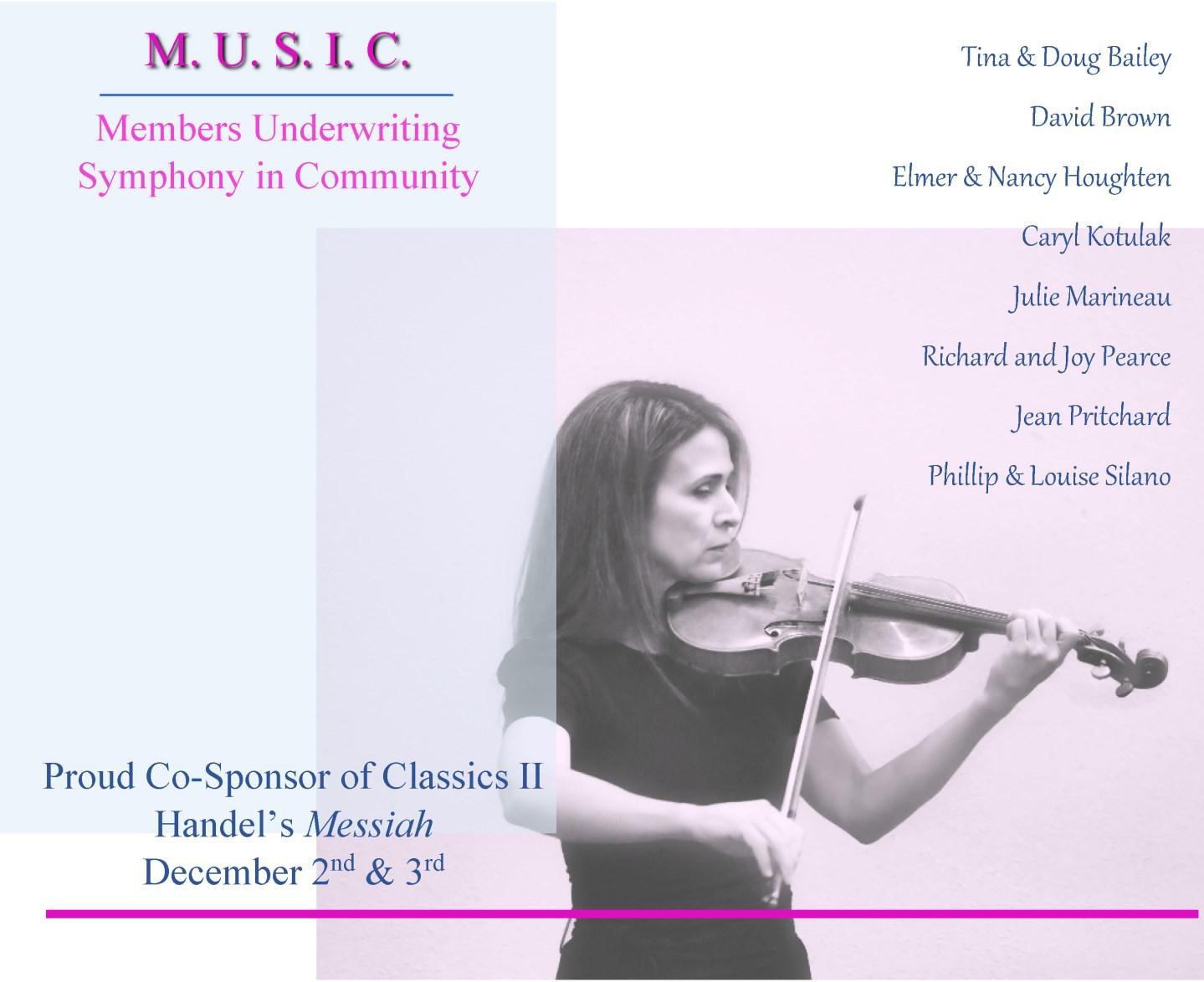

25


26





27


28




























